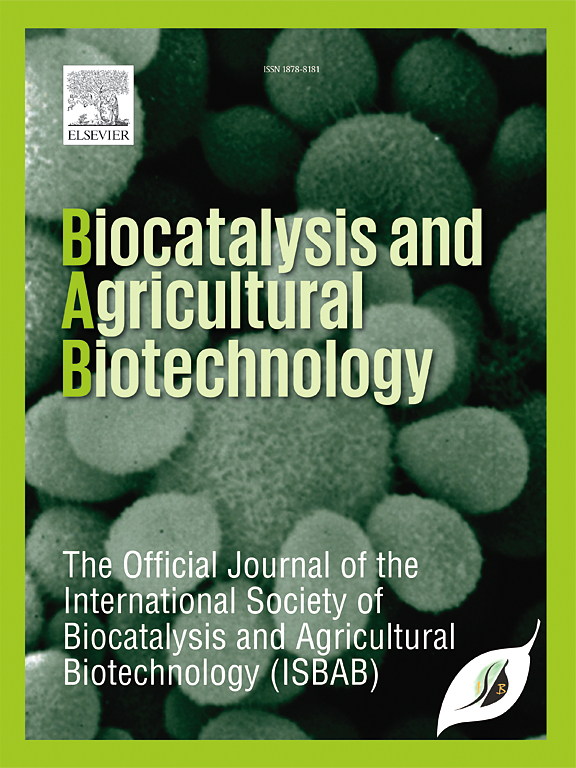探索产细菌素的阿尔及利亚乳酸菌的功能和益生菌潜力
IF 3.8
Q2 BIOTECHNOLOGY & APPLIED MICROBIOLOGY
引用次数: 0
摘要
传统食品生态位中的乳酸菌因其有益特性而受到越来越多的关注。在本研究中,选择了先前从实验室制备的卡迪德中分离和表征的产细菌素乳酸菌菌株。体外筛选乳酸菌的益生菌潜力,包括抑制单核增生李斯特菌FBUNT生物膜的形成、抗氧化能力和γ-氨基丁酸(GABA)的产生。在益生菌特性的研究中,产菌乳酸菌的表面特征显示它们大多数是亲水的,而乳酸菌(latlactobacillus (Lat.) sakei subsp。sakei K26表现出较强的自聚集性和疏水性,二者呈正相关(Pearson (r))。此外,拟植物乳杆菌(Lpb.) K18对所测低ph值和胆盐的抗性最强,能够承受胃肠道(GIT)条件。根据改性的MRS培养基组成,在聚苯乙烯板上粘附不同的生物膜形成模式,提高了Lat的产量。sakei无性系种群。sakik26和Lpb。发现paraplantarum K18。当细菌素样抑制物质对单核增生乳杆菌的生物膜进行试验时,Lat。sakei无性系种群。sakik26, Lat。sakik25和Lpb。拟植物K18在减少病原菌方面效果最好,这与它们产生细菌素和生物表面活性剂的能力有关。乳酸杆菌菌株具有可变自由基清除活性(DPPH˙和HO˙)和抗脂质过氧化活性,而GABA产生试验显示Lpb。在30°C条件下培养15天后,拟植物K18达到18.63 mM,转化率为~ 6.9%。在这些基础上,结合先前的结果,Lpb的有益作用。paraplantarum K18支持其作为功能性/益生菌发酵剂的潜力,用于开发新的和安全的发酵肉制品。本文章由计算机程序翻译,如有差异,请以英文原文为准。
Exploring the functional and probiotic potential of bacteriocin-producing lactobacilli from Algerian Kaddid
Research on lactobacilli from traditional food niches have received increasing attention for their beneficial properties. In this study, selected bacteriocin-producing lactobacilli strains previously isolated and characterized from laboratory-prepared Kaddid were used. The lactobacilli were screened in vitro for their probiotic potential including inhibition of Listeria (L.) monocytogenes FBUNT biofilm formation, antioxidant capacity and γ-aminobutyric acid (GABA) production. When probiotic features were investigated, surface characterization of bacteriocinogenic lactobacilli revealed most of them as hydrophilic, however Latilactobacillus (Lat.) sakei subsp. sakei K26 exhibited strong auto-aggregative and hydrophobic character with a positive Pearson (r) correlation between the two characteristics. In addition, Lactiplantibacillus (Lpb.) paraplantarum K18 was the most resistant to assayed low pHs and bile salts being able to withstand gastrointestinal tract (GIT) conditions. Variable biofilm formation patterns were displayed by adhesion in polystyrene plates depending on the modified MRS media composition, higher production for Lat. sakei subsp. sakei K26 and Lpb. paraplantarum K18 was found. When bacteriocin-like inhibitory substances were tested against L. monocytogenes biofilm, Lat. sakei subsp. sakei K26, Lat. sakei K25 and Lpb. paraplantarum K18 were the most efficient at reduced the pathogen in correlation with their ability to produce bacteriocins and biosurfactants. Variable free radical scavenging activity (DPPH˙ and HO˙) and anti-lipid peroxidation was found in lactobacilli strains, while GABA production assay showed Lpb. paraplantarum K18 to reach 18.63 mM with a conversion rate of ∼6.9 % after incubation at 30 °C for 15 days. On these bases and together with previous results, the beneficial effect of Lpb. paraplantarum K18 support its potential to be used as functional/probiotic starter culture for the development of new and safety fermented meat products.
求助全文
通过发布文献求助,成功后即可免费获取论文全文。
去求助
来源期刊

Biocatalysis and agricultural biotechnology
Agricultural and Biological Sciences-Agronomy and Crop Science
CiteScore
7.70
自引率
2.50%
发文量
308
审稿时长
48 days
期刊介绍:
Biocatalysis and Agricultural Biotechnology is the official journal of the International Society of Biocatalysis and Agricultural Biotechnology (ISBAB). The journal publishes high quality articles especially in the science and technology of biocatalysis, bioprocesses, agricultural biotechnology, biomedical biotechnology, and, if appropriate, from other related areas of biotechnology. The journal will publish peer-reviewed basic and applied research papers, authoritative reviews, and feature articles. The scope of the journal encompasses the research, industrial, and commercial aspects of biotechnology, including the areas of: biocatalysis; bioprocesses; food and agriculture; genetic engineering; molecular biology; healthcare and pharmaceuticals; biofuels; genomics; nanotechnology; environment and biodiversity; and bioremediation.
 求助内容:
求助内容: 应助结果提醒方式:
应助结果提醒方式:


